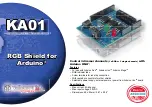
Note:
In addition to the Hibernation signals that are part of the Hibernation Module, GPIO pins
K[7:4] can be configured as external wake sources. Refer to “Waking from
Hibernate” on page 546 for more information.
Note:
Port pins
PM[7:4]
operate as Fast GPIO pads but support only 2-, 4-, 6-, and 8-mA drive
capability. 10- and 12-mA drive are not supported. All standard GPIO register controls,
except for the
GPIODR12R
register, apply to these port pins. Refer to “General-Purpose
Input/Outputs (GPIOs)” on page 742 and “Recommended GPIO Operating
Characteristics” on page 1820 for more information.
Table 7-1. Hibernate Signals (128TQFP)
Description
Buffer Type
Pin Type
Pin Mux / Pin
Assignment
Pin Number
Pin Name
An output that indicates the processor is in
Hibernate mode.
TTL
O
fixed
65
HIB
Buffered version of the Hibernation module's
32.768-kHz clock. This signal is not output when
the part is in Hibernate mode and before being
configured after power-on reset.
TTL
O
PC5 (7)
PK7 (5)
PP3 (7)
24
60
104
RTCCLK
Tamper signal 0.
TTL
I/O
PM7
71
TMPR0
Tamper signal 1.
TTL
I/O
PM6
72
TMPR1
Tamper signal 2.
TTL
I/O
PM5
73
TMPR2
Tamper signal 3.
TTL
I/O
PM4
74
TMPR3
Power source for the Hibernation module. It is
normally connected to the positive terminal of a
battery and serves as the battery
backup/Hibernation module power-source supply.
Power
-
fixed
68
VBAT
An external input that brings the processor out of
Hibernate mode when asserted.
TTL
I
fixed
64
WAKE
Hibernation module oscillator crystal input or an
external clock reference input. Note that this is
either a crystal or a 32.768-kHz oscillator for the
Hibernation module RTC.
Analog
I
fixed
66
XOSC0
Hibernation module oscillator crystal output. Leave
unconnected when using a single-ended clock
source.
Analog
O
fixed
67
XOSC1
7.3
Functional Description
The Hibernation module provides two mechanisms for power control:
■ The first mechanism uses internal switches to control power to the Cortex-M4F as well as to
most analog and digital functions while retaining I/O pin power (VDD3ON mode).
■ The second mechanism controls the power to the microcontroller with a control signal (
HIB
) that
signals an external voltage regulator to turn on or off.
The Hibernation module power source is supplied by V
DD
as long as it is within a valid range, even
if V
BAT
>V
DD
. The Hibernation module also has an independent clock source to maintain a real-time
clock (RTC) when the system clock is powered down. Hibernate mode can be entered through one
of two ways:
June 18, 2014
534
Texas Instruments-Production Data
Hibernation Module
















































